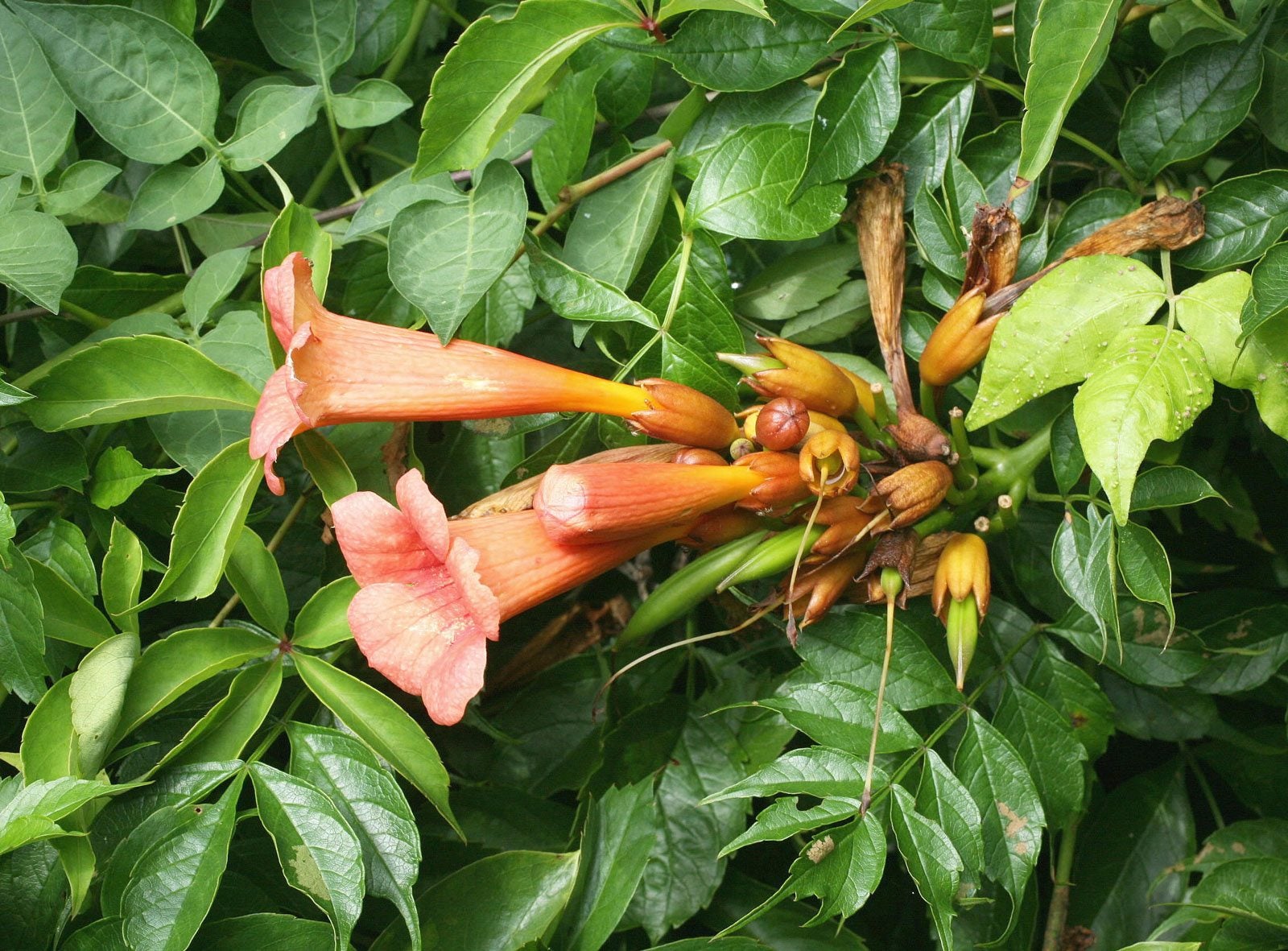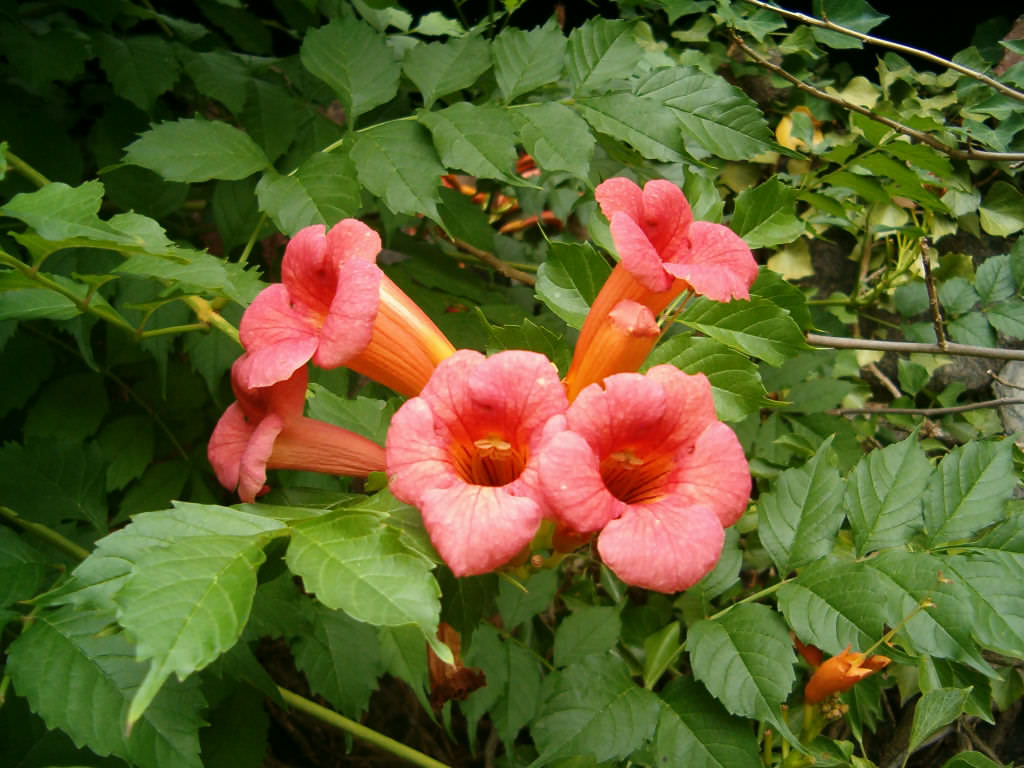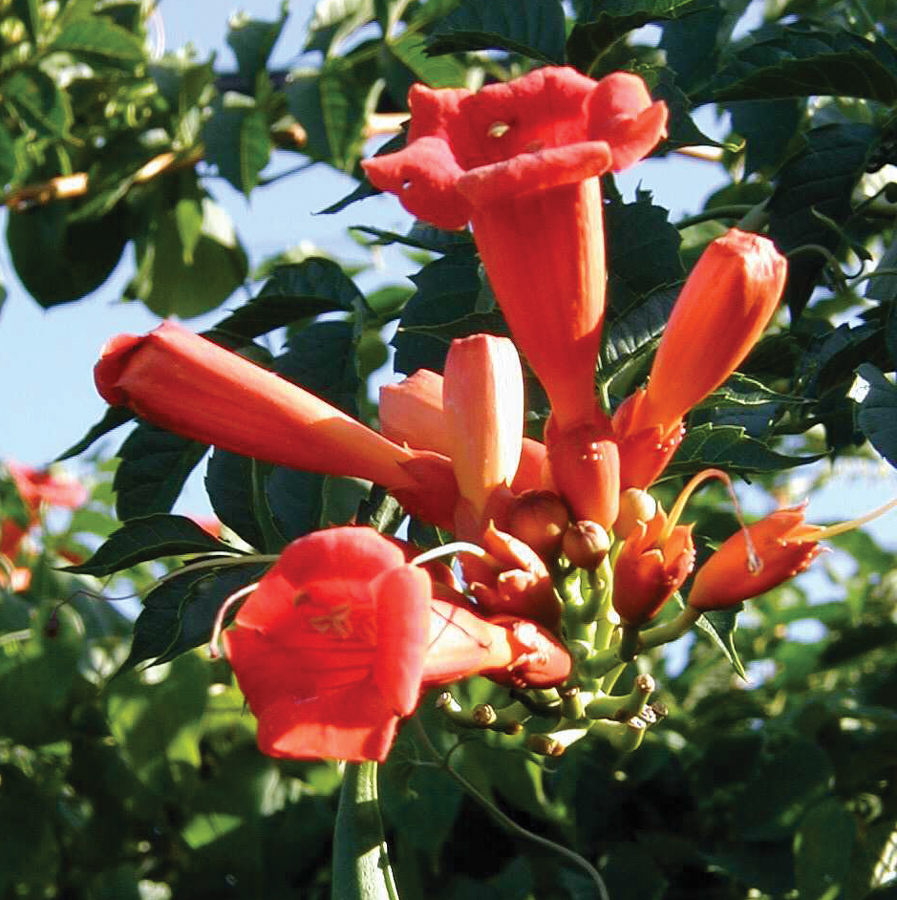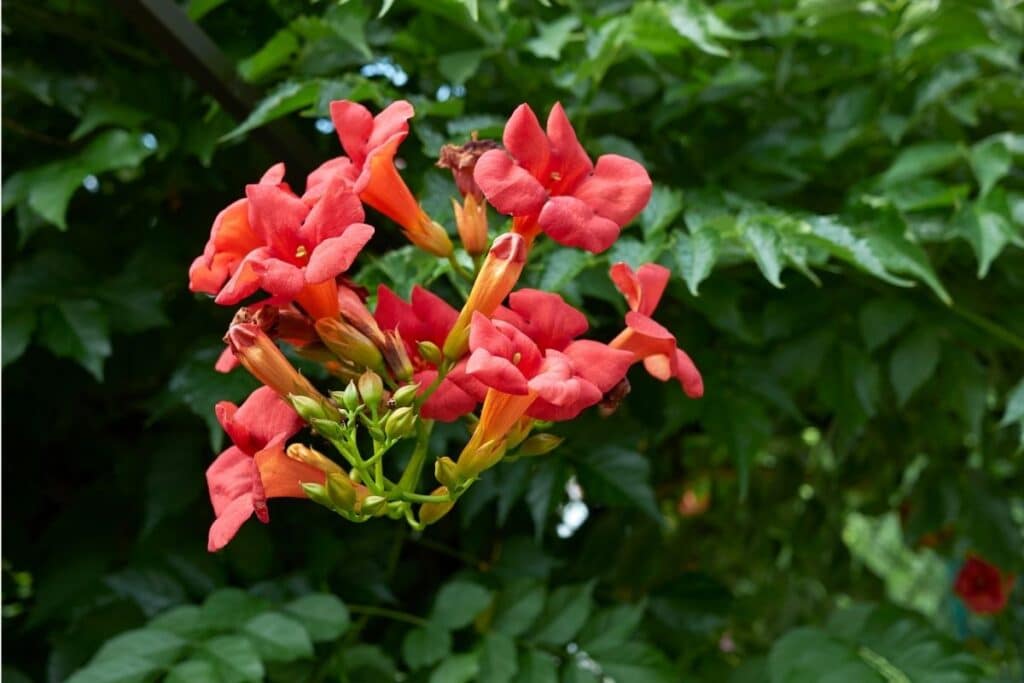What is Trumpet Vine and Why is it Important to Identify
Trumpet vine, also known as Campsis radicans, is a vigorous and fast-growing perennial plant native to the southeastern United States. It is a popular choice for gardeners and landscapers due to its showy, trumpet-shaped flowers and ability to thrive in a variety of conditions. However, identifying trumpet vine is crucial for proper care and maintenance, as it can be invasive and outcompete other plants if not managed correctly.
Understanding what trumpet vine looks like is essential for gardeners, as it can help them distinguish it from other plants and make informed decisions about its care. Trumpet vine can grow up to 40 feet tall, with a spread of up to 10 feet, making it a significant presence in any garden or landscape. Its leaves are pinnately compound, with 7-11 leaflets that are dark green in color. The plant’s flowers are its most distinctive feature, with showy, trumpet-shaped blooms that are typically orange to red in color.
Identifying trumpet vine is also important for environmental reasons. The plant can be invasive in some areas, outcompeting native species and potentially harming local ecosystems. By understanding what trumpet vine looks like, gardeners and landscapers can take steps to prevent its spread and protect the environment.
In addition to its environmental impact, trumpet vine can also be a nuisance in gardens and landscapes if not properly managed. Its vigorous growth habit can cause it to overwhelm other plants, and its roots can be difficult to eradicate. By identifying trumpet vine and taking steps to control its growth, gardeners and landscapers can prevent these problems and keep their gardens and landscapes healthy and thriving.
Physical Characteristics of Trumpet Vine: Leaves, Flowers, and Stems
Trumpet vine is a distinctive plant with several physical characteristics that make it easily recognizable. One of the most notable features of trumpet vine is its leaves, which are pinnately compound and consist of 7-11 leaflets. The leaflets are dark green in color, with a smooth texture and a pointed tip. They are arranged oppositely on the stem, with each leaflet measuring between 2-4 inches in length.
The flowers of trumpet vine are its most showy feature, with large, trumpet-shaped blooms that are typically orange to red in color. The flowers are 2-3 inches in length and have a flared shape, with five petals that are fused together. They are arranged in clusters at the end of the stems, and are highly fragrant, attracting hummingbirds and other pollinators.
The stems of trumpet vine are woody and vigorous, with a brownish-gray color and a rough texture. They can grow up to 40 feet in length, and are often covered in small, sharp thorns. The stems are also highly flexible, allowing the plant to climb up trees and other supports.
When trying to determine what trumpet vine looks like, it’s essential to examine the plant’s overall growth habit. Trumpet vine is a vigorous grower, and can quickly cover large areas with its sprawling stems. It prefers well-drained soil and full sun to partial shade, making it a popular choice for gardens and landscapes.
By examining the physical characteristics of trumpet vine, including its leaves, flowers, and stems, gardeners and landscapers can gain a better understanding of what this plant looks like and how to identify it. This knowledge is essential for proper care and maintenance, as well as for preventing the plant’s invasive tendencies.
How to Identify Trumpet Vine: A Step-by-Step Guide
Identifying trumpet vine requires a combination of observing its physical characteristics, growth habits, and flowering patterns. To accurately identify what does trumpet vine look like, follow these steps:
Step 1: Observe the Leaves
Trumpet vine leaves are typically 4-8 inches long, with 7-11 pointed lobes. They are dark green on top and lighter green on the bottom. The leaves are arranged oppositely on the stem, meaning they grow in pairs on either side of the stem. Take note of the leaf shape, size, and arrangement to help identify the plant.
Step 2: Examine the Flowers
Trumpet vine flowers are showy, trumpet-shaped, and typically 2-4 inches long. They are orange to red in color, with a flared mouth and a long, tube-like structure. The flowers grow in clusters at the end of the stems and are highly fragrant. Observe the flower shape, color, and arrangement to help identify the plant.
Step 3: Inspect the Stems
Trumpet vine stems are woody, brown, and can grow up to 40 feet long. They have a rough, hairy texture and can grow quite thick. The stems can be either twining or trailing, depending on the support available. Take note of the stem color, texture, and growth habit to help identify the plant.
Step 4: Observe the Growth Habit
Trumpet vine is a vigorous grower and can quickly cover large areas. It can grow as a twining vine, a trailing groundcover, or a shrub-like plant. Observe the plant’s growth habit and how it interacts with its surroundings to help identify it.
Step 5: Check for Other Characteristics
Trumpet vine has a number of other characteristics that can help with identification. It produces bean-like seed pods in the fall, and the seeds are dispersed by birds and other animals. The plant also has a distinctive, pungent odor that can be noticeable when the leaves or stems are bruised.
By following these steps and observing the physical characteristics, growth habits, and flowering patterns of the plant, you can accurately identify what does trumpet vine look like and distinguish it from similar plants.
Distinguishing Trumpet Vine from Similar Plants
When trying to identify what does trumpet vine look like, it’s essential to be aware of similar plants that may be mistaken for trumpet vine. Two common lookalikes are honeysuckle and clematis. While these plants share some similarities with trumpet vine, they have distinct characteristics that set them apart.
Honeysuckle (Lonicera spp.) is a climbing vine with fragrant, white, yellow, or pink flowers. However, honeysuckle leaves are typically smaller and more oval-shaped than trumpet vine leaves. Additionally, honeysuckle stems are more slender and twine around supports in a clockwise direction, whereas trumpet vine stems are thicker and twine counterclockwise.
Clematis (Clematis spp.) is a flowering vine with showy, bell-shaped flowers in shades of pink, purple, and white. While clematis flowers may resemble trumpet vine flowers, they are typically more delicate and have a different shape. Clematis leaves are also more deeply lobed and have a more pronounced leaf stem than trumpet vine leaves.
Another plant that may be mistaken for trumpet vine is the crossvine (Bignonia capreolata). Crossvine has similar, trumpet-shaped flowers, but they are typically more yellow-orange in color and have a distinctive, crossed pattern on the petals. Crossvine leaves are also more rounded and have a softer texture than trumpet vine leaves.
To accurately identify trumpet vine and distinguish it from these lookalikes, observe the plant’s overall growth habit, leaf shape and size, flower shape and color, and stem texture and twining pattern. By paying attention to these characteristics, you can confidently identify what does trumpet vine look like and avoid misidentifying similar plants.
Trumpet Vine Varieties: Different Types and Their Unique Features
While the common trumpet vine (Campsis radicans) is the most widely recognized variety, there are several other types of trumpet vine that offer unique features and characteristics. Understanding these differences can help you identify what does trumpet vine look like and choose the best variety for your garden or landscape.
One popular variety is the Chinese trumpet vine (Campsis grandiflora), which produces larger, more fragrant flowers than the common trumpet vine. This variety is also more vigorous and can grow up to 50 feet tall, making it a great choice for covering large areas or providing shade.
Another variety is the Trumpet Vine ‘Indian Summer’ (Campsis radicans ‘Indian Summer’), which produces bright orange-red flowers with a yellow throat. This variety is more compact than the common trumpet vine, growing up to 20 feet tall, and is a great choice for smaller gardens or containers.
The Trumpet Vine ‘Dropmore Scarlet’ (Campsis radicans ‘Dropmore Scarlet’) is a variety that produces deep red flowers with a yellow throat. This variety is more vigorous than the common trumpet vine and can grow up to 30 feet tall, making it a great choice for covering large areas or providing shade.
In addition to these varieties, there are also several hybrids and cultivars of trumpet vine that offer unique features and characteristics. For example, the Trumpet Vine ‘Flava‘ (Campsis radicans ‘Flava’) produces yellow flowers, while the Trumpet Vine ‘Prairie Flame’ (Campsis radicans ‘Prairie Flame’) produces bright orange-red flowers with a yellow throat.
When trying to identify what does trumpet vine look like, it’s essential to consider the unique features and characteristics of each variety. By understanding these differences, you can choose the best variety for your garden or landscape and provide the proper care and maintenance for optimal growth and flowering.
Trumpet Vine in Different Seasons: How to Identify in Spring, Summer, Fall, and Winter
Trumpet vine is a deciduous plant that changes its appearance throughout the year. Understanding how to identify trumpet vine in different seasons can help you recognize the plant and provide proper care and maintenance. Here’s a breakdown of what does trumpet vine look like in each season:
Spring: In the spring, trumpet vine begins to produce new growth, including leaves and stems. The leaves are typically a bright green color and have a distinctive, pinnate shape. The stems are thin and wiry, and the plant may produce a few flowers in the late spring. To identify trumpet vine in the spring, look for the new growth and the characteristic leaf shape.
Summer: During the summer months, trumpet vine is in full bloom, producing showy, trumpet-shaped flowers in shades of orange, red, and yellow. The flowers are highly fragrant and attract hummingbirds and other pollinators. The leaves are a deep green color and the stems are thicker and more robust. To identify trumpet vine in the summer, look for the bright flowers and the characteristic leaf shape.
Fall: In the fall, trumpet vine begins to produce seed pods, which are long and bean-like. The leaves turn a yellow or orange color before falling off the plant. The stems begin to die back, and the plant may appear dormant. To identify trumpet vine in the fall, look for the seed pods and the characteristic leaf shape.
Winter: During the winter months, trumpet vine is dormant, and the stems may appear dead. However, the plant is still alive, and the roots are preparing for new growth in the spring. To identify trumpet vine in the winter, look for the characteristic stem shape and the presence of seed pods.
By understanding how to identify trumpet vine in different seasons, you can recognize the plant and provide proper care and maintenance. Remember to look for the characteristic leaf shape, flower shape, and stem shape to ensure accurate identification.
Common Mistakes in Identifying Trumpet Vine
When trying to identify what does trumpet vine look like, it’s easy to make mistakes. Here are some common errors to watch out for:
Misidentifying Similar Plants: One of the most common mistakes is misidentifying trumpet vine with similar plants like honeysuckle or clematis. While these plants share some similarities with trumpet vine, they have distinct characteristics that set them apart. Make sure to observe the plant’s growth habits, leaf patterns, and flower shapes to ensure accurate identification.
Overlooking Key Characteristics: Trumpet vine has several key characteristics that distinguish it from other plants. Overlooking these characteristics can lead to misidentification. For example, trumpet vine has a distinctive, pinnate leaf shape and produces showy, trumpet-shaped flowers. Make sure to observe these characteristics when trying to identify the plant.
Not Considering the Plant’s Growth Habits: Trumpet vine is a vigorous grower and can quickly cover large areas. Not considering the plant’s growth habits can lead to misidentification. For example, trumpet vine can grow as a twining vine, a trailing groundcover, or a shrub-like plant. Make sure to observe the plant’s growth habits to ensure accurate identification.
Not Observing the Plant’s Flowers: Trumpet vine produces showy, trumpet-shaped flowers that are highly fragrant. Not observing the plant’s flowers can lead to misidentification. Make sure to observe the flower shape, color, and arrangement to ensure accurate identification.
Not Considering the Plant’s Seasonal Changes: Trumpet vine changes its appearance throughout the year. Not considering the plant’s seasonal changes can lead to misidentification. For example, trumpet vine produces new growth in the spring, flowers in the summer, and seed pods in the fall. Make sure to observe the plant’s seasonal changes to ensure accurate identification.
By being aware of these common mistakes, you can avoid misidentifying trumpet vine and ensure accurate identification. Remember to observe the plant’s growth habits, leaf patterns, flower shapes, and seasonal changes to ensure accurate identification.
Conclusion: Mastering Trumpet Vine Identification
Identifying trumpet vine can be a challenging task, but with the right knowledge and skills, it can be done with ease. By understanding the physical characteristics of the plant, including its leaves, flowers, and stems, and by being aware of the common mistakes people make when trying to identify it, you can master the art of trumpet vine identification.
Remember, identifying what does trumpet vine look like requires attention to detail and a thorough understanding of the plant’s growth habits, leaf patterns, and flower shapes. By following the step-by-step guide provided in this article, you can confidently identify trumpet vine and distinguish it from similar plants.
With practice and patience, you can become an expert in identifying trumpet vine and other plants. Don’t be afraid to get out into the field and start observing the plants around you. With time and experience, you will develop the skills and knowledge needed to accurately identify trumpet vine and other plants.
In conclusion, identifying trumpet vine is a valuable skill that can be developed with practice and patience. By following the guidelines and tips provided in this article, you can master the art of trumpet vine identification and become a more confident and skilled gardener or naturalist.


:strip_icc()/yellow-trumpet-vine-fc2b288b-f60899c0dd334af297c9458e464774c5.jpg)




